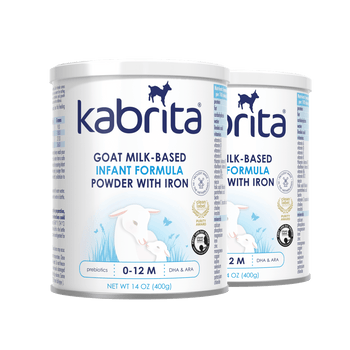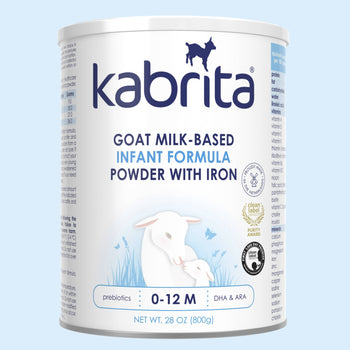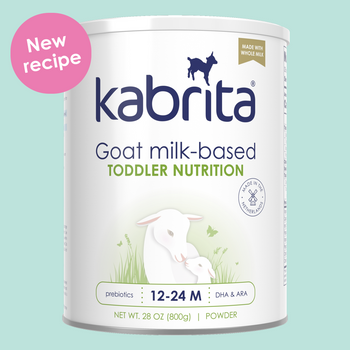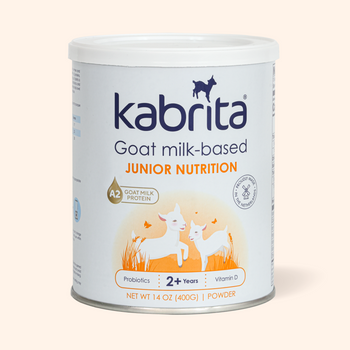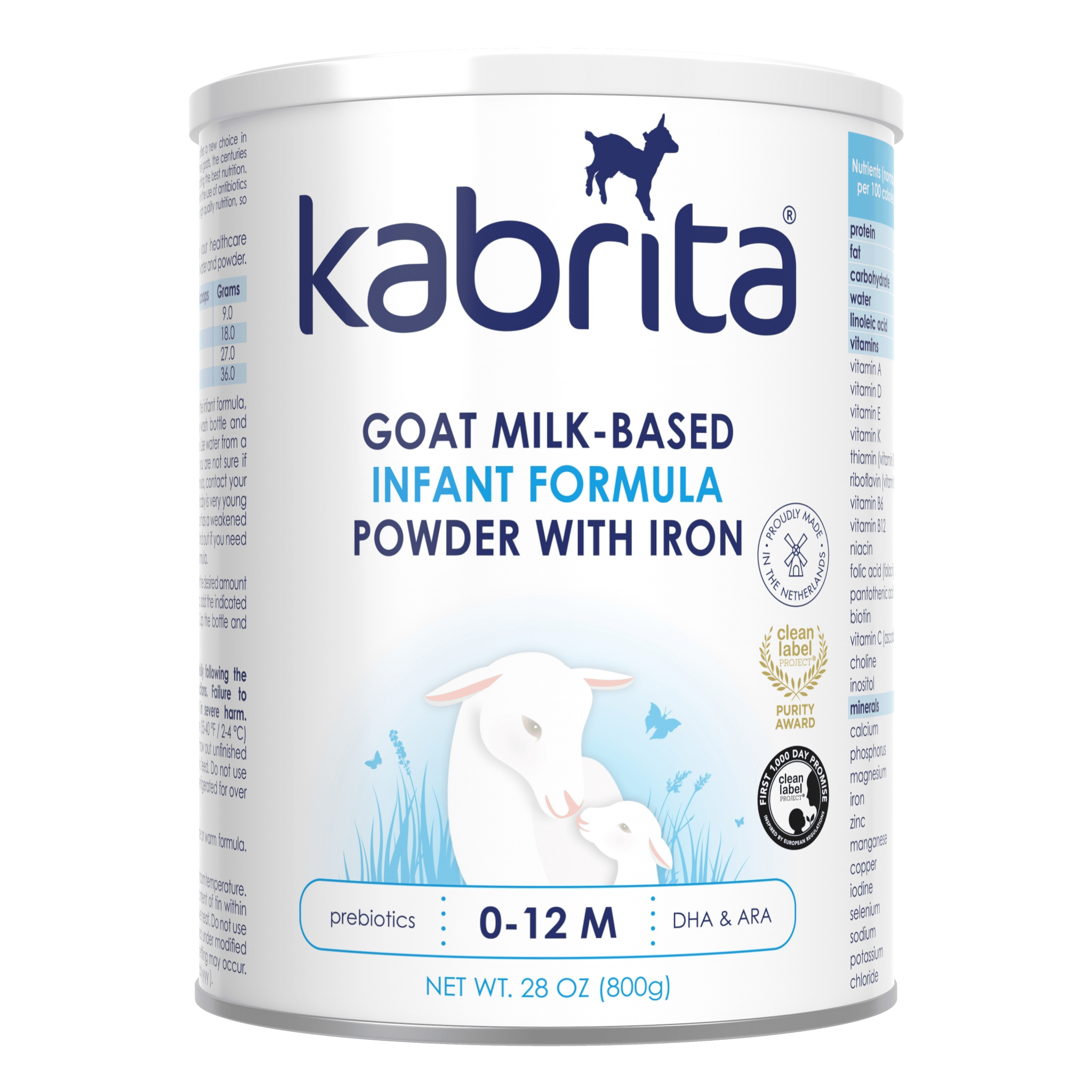Choosing how to nourish your baby is one of the most personal decisions you make as a new parent, and whether breastfeeding isn’t possible, isn’t preferred, or you need to supplement, you’re making sure to choose what’s best for your family. Your baby can absolutely thrive, whether exclusively breastfed, combo-fed, or nourished solely through infant formula. If you’re searching for the closest formula to breast milk, you’re not alone!
Breastmilk is seen as the clinical gold standard for infant nutrition, and many parents are looking for a formula that mimics its natural nutritional qualities.1 Goat milk-based infant formula has become a popular breastmilk alternative, as its gentle nutrition composition tends to be naturally closer to breastmilk than traditional cow milk-based infant formula.
Keep reading to learn about the key qualities of breastmilk that make it the number one recommendation for infants and how goat milk-based infant formula can be an excellent alternative to breastmilk should you decide to supplement or fully nourish your baby with infant formula.
Table of contents
What makes a formula similar to breastmilk?
Is goat milk formula closest to breastmilk?
Goat Milk Formula as a Breastmilk Alternative
FAQs on Formula and Breastmilk
What makes a formula similar to breastmilk?
The American Academy of Pediatrics (AAP) recommends that infants are exclusively breastfed up to six months of age, and stresses that breastfeeding continues to be beneficial up to the age of two.2 FDA-regulated infant formulas include 30 vitamins and minerals essential for infant growth and development as well as appropriate amounts of protein, carbohydrates, and fatty acids.
While infant formula meets your baby’s nutritional needs the way breastmilk does, the advantages breastmilk provides as a living food are impossible for a formula to replicate exactly. “Researchers are still learning a great deal about the properties that are unique to human milk, but infant formula offers the best way to create an acceptable substitute based on the typical nutrients found in breast milk,” says Ari Brown, MD, FAAP.
Key Qualities of Breastmilk
Breastmilk provides all the nutrition your baby needs, aside from vitamin D, which tends to be low in human breastmilk.3 In addition to the protein, fat, carbohydrates, vitamins, and minerals breastmilk provides, it also has these key qualities:
Natural Antibodies
“Breast milk contains all the antibodies that a nursing mother has produced over her entire life and ingredients that offer important immune protection,” says Dr Brown. Colostrum, or the first milk that’s expressed, contains the highest amount of antibodies, but your baby will continue to receive them through breast milk as long as they’re nursing.4 These antibodies can help strengthen your baby’s immune system throughout their entire life, offering them protection throughout infancy, childhood, and as adults.
Easily Digestible
Breastmilk is one of the easiest foods for a baby to digest, as its composition is specifically designed for a baby’s young, and often immature, digestive system. The protein in breastmilk are more easily digested than proteins in other types of milk, specifically it’s very low in alpha s1 casein, a protein abundant in cow milk that can be difficult for young digestive systems to break down and absorb (cow milk is predominantly alpha s1 casein, commonly referred to as a1 protein).5 The protein that is found in breastmilk is more easily digested and forms softer curds, which supports softer and more frequent bowel movements.6
Human Milk Oligosaccharides (HMO’s)
One of the amazing qualities of breastmilk is how different its composition can be from one mother to another. “Breast milk contains Human Milk Oligosaccharides (HMO’s), which are bioactive carbohydrates that support the growth of good gut bacteria and immune function,” explains Dr. Brown. But not every mother’s breastmilk offers the same composition. “HMO’s have hundreds of variants compared to other animal milks, and every nursing mother has different HMO’s in her breast milk,” adds Dr. Brown.
Is goat milk-based infant formula closest to breastmilk?
Goat Milk-Based Infant Formula vs Other Formulas
When determining which type of formula is closest to breastmilk, we have to look at all formulas offered to infants as a breastmilk substitute or supplement. While goat milk-based infant formula, cow milk-based infant formula, soy milk-based infant formula, hydrolyzed, and specialty infant formulas all include the nutrients essential for your baby’s growth, goat milk-based infant formula is, by nature, the most similar to breastmilk. This gives it a significant advantage over many other formulas, especially for babies with sensitive digestive systems.
The AAP endorses goat milk-based infant formula as a safe and nutritious option for most healthy term babies. The exception is for babies with a true cow milk allergy or those with galactosemia who cannot process the byproduct of lactose. Babies with either of these conditions require a hydrolyzed infant formula or soy-based formula, depending on their unique needs.
Nutritional Similarities Between Goat Milk and Breastmilk
Goat milk-based infant formula tends to be naturally more similar to breastmilk than other types of infant formulas thanks to the protein composition and naturally occuring oligosaccharides. These similarities help make goat milk formula easier on sensitive tummies than cow milk formula often is.
“Kabrita goat milk based infant formula naturally contains more Beta casein protein, less Alpha S1 casein, and more Alpha S2 casein–resulting in softer, looser digestive products called curds, which are easier to digest,” says Dr. Brown. The rate at which protein in goat milk is digested is also similar to the digestive rate of the proteins in breastmilk, while cow milk proteins take longer to digest.5 “Kabrita modifies the protein whey:casein ratio to 60:40, to match the same ratio found in human milk,” says Dr. Brown.
“Goat milk also naturally contains more variety and volume of an important sugar (and bioactive ingredient) called oligosaccharides compared to cow milk,” says Dr. Brown. While goat milk doesn’t have as many and as wide of a variety of oligosaccharides as HMO, Kabrita adds additional galacto-oligosaccharides (GOS) to more closely mimic the composition found in human milk.7,8
Most, if not all, infant formulas, including Kabrita, a European goat milk-based infant formula, add DHA and ARA, fatty acids naturally found in breastmilk that are important for vision and brain development, explains Dr. Brown.
Goat Milk Formula as a Breastmilk Alternative
The Benefits of Goat Milk
While cow milk-based infant formula has been traditionally used in the United States, goat milk-based infant formula options have become much more popular over the past decade. Goat milk infant formula is a natural alternative to breastmilk thanks to the similarities in protein structure and oligosaccharides. This helps make goat milk-based infant formula easier to digest for babies with sensitive tummies.
Because the protein structures are more similar to breastmilk, they produce similar soft, small curds during the digestive process, which is much more gentle on your baby’s tummy, explains Dr. Brown. If your baby seems to be fussy, uncomfortable, gassy, bloated, or constipated on traditional formula, goat milk-based infant formula may help relieve some of their digestive symptoms.
FAQs on Formulas & Breastmilk
Can You Mix Goat Milk Formula With Breastmilk?
Formula should always be made according to the manufacturer's instructions. As long as the formula is prepared according to the instructions on the can, the prepared formula can be combined with breastmilk in the same bottle. You can also feed your baby appropriately prepared formula before or after breastfeeding or bottle-feeding breastmilk.
What Formula is Closest to Breastmilk?
Goat milk-based infant formula with whey added, for a 60:40 whey to casein ratio, that also has added DHA/ARA, iron, lactose, and oligosaccharides in addition to the 30 essential nutrients required by the FDA for infant formula, is most similar to breastmilk.
What Milk is Closest to Breastmilk?
Comparing goat milk, cow milk, and plant-based milk alternatives, goat milk is, by nature, the closest to breastmilk thanks to its protein and carbohydrate composition.
How To Introduce Goat Milk Formula To A Breastfed Baby?
Introducing goat milk infant formula to your baby is very straightforward. “Most breastfed babies do great and tolerate goat milk-based infant formula when it is introduced, so there is no need to worry or to gradually introduce small volumes of it. It is helpful to have a consistent amount of breastmilk and infant formula in your baby's diet on a daily basis when you are combo feeding--so your baby isn't getting say, 80% breastmilk one day and 20% the next,” advises Dr. Brown. “You may notice a change in your baby’s stool frequency, color, and consistency and that’s okay!”
Which Formula is Closest to Breastmilk?
Goat milk infant formula is naturally closer to breastmilk than cow milk-based infant formula due to the protein and carbohydrate composition.
Is It Ok To Alternate Formula And Breastmilk?
Yes! Infant formula and breastmilk can be alternated and fed at different times throughout the day. This works well if you choose to combo feed due to reduced supply, heading back to work, traveling, or while transitioning your baby to formula.
Which Infant Formula Is Equivalent To Breastmilk?
No formula can exactly mimic breastmilk, although goat milk-based infant formula is naturally more similar to breastmilk than a cow milk-based infant formula.
What Is The Best Formula To Introduce To A Breastfed Baby?
While pediatricians recommend breastmilk as the first option for infant feeding, Dr. Brown stresses that there is support for parents who choose to feed their baby formula, no matter the reason. “We support everyone’s feeding goals to ensure their baby grows and thrives. When a parent asks for advice regarding which infant formula to choose, I do recommend Kabrita,” says Dr. Brown.
No matter how you choose to nourish your baby, it’s important to feel confident in your decision and know that you are doing what’s best for your family. If breastfeeding isn’t an option or if you’re looking to supplement, goat milk-based infant formula can be a gentle, effective alternative that mimics many of the beneficial nutritional qualities of breastmilk. Kabrita goat milk-based infant formula is designed to be well-tolerated by babies, especially those with sensitive tummies, and provides essential nutrients your baby needs.
References
Goat Milk Infant Formula
Meet our award winning, European-made infant formula that's naturally closer to breast milk.
